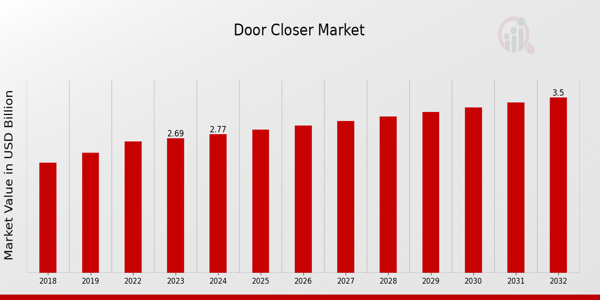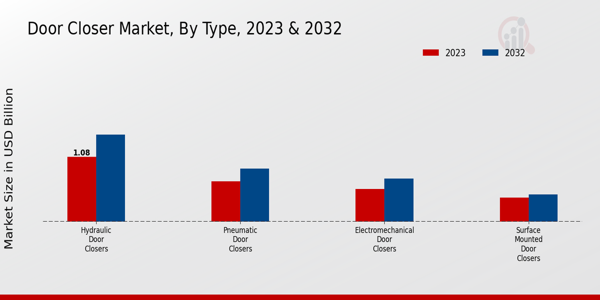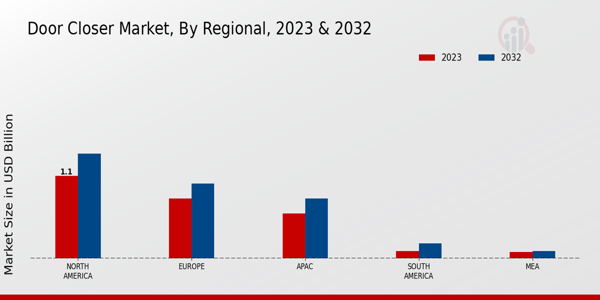Global Door Closer Market Overview
As per MRFR analysis, the Door Closer Market Size was estimated at 2.62 (USD Billion) in 2022. The Door Closer Market Industry is expected to grow from 2.69(USD Billion) in 2023 to 3.5 (USD Billion) by 2032. The Door Closer Market CAGR (growth rate) is expected to be around 2.94% during the forecast period (2024 - 2032).
Key Door Closer Market Trends Highlighted
The Door Closer Market is influenced by various key market drivers, including the growing demand for enhanced safety and security solutions in residential and commercial spaces. Increased construction activities and urbanization boost the installation of door closers, as they play a crucial role in energy efficiency by ensuring that doors close properly, thereby maintaining temperature control. Additionally, stringent building codes and regulations regarding fire safety and accessibility drive the adoption of door closers in new buildings. The rise in awareness regarding safety standards has amplified the preference for automatic and sensor-based door closers, further propelling the market growth.There are numerous opportunities to be explored in the Door Closer Market, particularly with the increasing integration of smart technologies. As smart homes and buildings become more prevalent, manufacturers have the chance to develop innovative door-closer solutions that incorporate IoT features, offering enhanced control and monitoring. Furthermore, expanding applications in niche markets such as healthcare, hospitality, and transportation sectors open new avenues for growth. Investing in R to create energy-efficient and sustainable products can also capture a larger market share as consumers become more environmentally conscious.Recent trends in the marketplace reveal a shift towards greater customization and personalization of door closers. Homeowners and businesses alike are seeking products that meet their specific needs, resulting in an increase in demand for tailored solutions. Moreover, the emergence of e-commerce platforms has changed how consumers purchase door closer products, making them more convenient and accessible. A growing focus on aesthetic appeal has also influenced design choices as consumers look for door closers that complement their interior decor. Collaboration between manufacturers and technology providers is becoming more common as both parties seek to enhance product offerings and improve user experience in an evolving market landscape.

Source: Primary Research, Secondary Research, MRFR Database and Analyst Review
Door Closer Market Drivers
Increased Demand for Safety and Security Solutions
The Door Closer Market Industry has witnessed a significant surge in demand due to the growing emphasis on safety and security across various sectors. As urbanization accelerates, particularly in developing regions, there is an increased focus on creating secure environments in residential, commercial and institutional spaces. Door closers play a crucial role in enhancing security by ensuring doors close automatically, reducing the risk of unauthorized access, and preventing forced entry.Additionally, regulatory standards regarding fire safety and accessibility are pushing for the installation of door closers in public buildings. These factors contribute to the market's growth by encouraging manufacturers to innovate and offer advanced door closer systems that comply with regulations while providing enhanced security features. As such, the increasing demand for comprehensive safety solutions drives the expansion of the Door Closer Market, leading to a more significant market value in the coming years.
Technological Advancements in Door Closer Systems
Technological innovations have significantly influenced the Door Closer Market Industry, as manufacturers are increasingly focusing on developing smart door closers that incorporate advanced features. The integration of electronic mechanisms and connectivity options facilitates automatic adjustments and remote control, catering to modern consumer preferences for convenience and efficiency. The advent of IoT technology has led to the rise of smart buildings where door closers can be integrated with overall building management systems, improving user experience and energy management.Additional features in demand are improved adjustable closing speeds, environmental sensors and noise reduction due to their appreciation value to the consumers and end-users, thereby expanding the market.
Growth in the Construction and Real Estate Sectors
The robust growth in the construction and real estate sectors is a significant driver for the Door Closer Market Industry. With increasing investments in infrastructure development, including residential, commercial, and institutional projects, the demand for door closers is expected to rise substantially. Builders and developers are incorporating door closers in their designs to comply with safety regulations and enhance functionality within buildings.Moreover, the trend towards sustainable building practices encourages the adoption of energy-efficient door-closing solutions, which contribute to the overall market expansion. As these sectors continue to flourish, they create ample opportunities for door-closer manufacturers to innovate and meet the evolving demands of the market.
Door Closer Market Segment Insight
Door Closer Market Type Insights
The Door Closer Market is witnessing a steady growth trajectory, with a current valuation of 2.69 USD Billion as of 2023 and a projected increase to 3.5 USD Billion by 2032, driven by the rising demand for efficient door control systems across various applications. Within this market segmentation based on Type, several product categories exhibit diverse characteristics and significance. Hydraulic Door Closers emerge as the most prominent, dominating the market with a valuation of 1.08 USD Billion in 2023 and expected to reach 1.45 USD Billion in 2032.The strength and reliability of hydraulic systems make them a preferred choice in commercial and residential applications, enhancing their demand significantly. Pneumatic Door Closers also contribute substantially, with a market value of 0.67 USD Billion in 2023 and projected growth to 0.88 USD Billion by 2032, offering a lighter and more flexible closing mechanism, which is favored in environments where noise reduction and smooth operation are prioritized. Electromechanical Door Closers, holding a valuation of 0.54 USD Billion in 2023, are gaining traction for their integration with automated systems, with expectations to grow to 0.72 USD Billion by 2032, thus tapping into the smart building trend that is reshaping modern infrastructure.Meanwhile, Surface Mounted Door Closers, typically valued at 0.4 USD Billion in 2023, are seeing gradual growth to 0.45 USD Billion by 2032, appealing largely due to their ease of installation and cost-effectiveness. Each type plays a pivotal role in the overall Door Closer Market dynamics, driven by distinct user requirements and operational advantages. While Hydraulic Door Closers dominate this landscape, the growing trend toward smart building solutions is likely to push Electromechanical Door Closers even further into the spotlight.Furthermore, innovations in technology and the rising need for automation open up additional opportunities within the Door Closer Market, enhancing its overall attractiveness to investors and stakeholders alike. As urbanization continues to grow and construction activities increase globally, the demand for these door control systems is expected to rise, reinforcing the importance of market segmentation and targeted applications in navigating future growth prospects. This diversification inherently drives competition and fosters innovation, ensuring a robust market evolution that aligns with contemporary consumer and industry needs.

Source: Primary Research, Secondary Research, MRFR Database and Analyst Review
Door Closer Market Application Insights
Door Closer MarketEach category plays a significant role in shaping the overall market dynamics. For residential applications, door closers enhance safety and convenience in homes, driving demand among homeowners. In the commercial sector, the use of door closers is often integral to ensuring accessibility and security in business premises, which contributes to consistent growth.Industrial applications showcase robust demand due to their necessity in environments requiring durability and efficiency. Institutional applications, such as hospitals and schools, also represent a critical segment as these facilities prioritize safety and compliance with regulations. The Door Closer Market statistics indicate that these application areas collectively contribute to a steadily increasing market growth trajectory, with a keen interest in integrating advanced technology. As trends evolve towards energy efficiency and enhanced safety protocols, opportunities abound for innovation and expansion across these key segments, manifesting a bright outlook for the Door Closer Market industry well into the next decade.
Door Closer Market Mechanism Insights
Door Closer MarketThis segment encompasses various types of door closers, including Automatic Closing, Self-Closing and Controlled Closing. Automatic Closing mechanisms are particularly noteworthy due to their convenience and ability to enhance security in residential and commercial environments. Self-closing mechanisms also play a critical role, ensuring that doors close promptly to maintain temperature control and energy efficiency.Controlled Closing mechanisms are significant as they offer adjustable speed and resistance, appealing to users who require customization for different door types. The market dynamics are influenced by growth drivers such as increasing urbanization and demand for enhanced safety features in buildings. Market trends indicate a notable rise in the use of automatic and controlled closing mechanisms, reflecting a shift towards smarter technologies in the Door Closer Market. Challenges may include varying regulations across regions that impact installation practices, but the opportunities for innovation in product design and functionality continue to expand, contributing to the evolving landscape of the market.Overall, the Door Closer Market segmentation clearly emphasizes the critical role of the Mechanism segment in driving both market growth and advancements in door technology.
Door Closer Market End Use Insights
Door Closer MarketThis segment is significantly impacted by factors such as the New Construction and Renovation sectors. The New Construction segment is vital as it comprises a consistent demand for door closers in newly built structures, driven by urbanization and increased construction activities. Renovation also plays a crucial role in the Door Closer Market, as existing buildings require upgrades, both for aesthetic improvements and compliance with safety regulations.The demand from the Renovation segment is significant due to the need for enhanced security and improved functionality in older infrastructures. As these two areas continue to expand, they are expected to contribute notably to the Door Closer Market revenue, reflecting the industry's adaptability to evolving consumer preferences and regulatory guidelines. Market trends are also leaning towards energy-efficient and automated door-closing solutions, creating opportunities for innovation while addressing current industry challenges. Overall, the interaction between New Construction and Renovation significantly shapes the Door Closer Market data and statistics, pointing to a robust future for the industry.
Door Closer Market Regional Insights
Door Closer MarketNorth America is the leading region, with a valuation of 1.1 USD Billion in 2023, demonstrating its major influence in the door closer industry due to heightened construction activities and safety regulations. Europe follows, valued at 0.8 USD Billion, capitalizing on the growing demand for energy-efficient building solutions. The Asia-Pacific (APAC) region, valued at 0.6 USD Billion, shows promising growth potential driven by rapid urbanization and infrastructural development.South America, while smaller at 0.1 USD Billion, exhibits growth opportunities as the region strengthens its construction sectors. The Middle East and Africa (MEA) represent the least share at 0.09 USD Billion, yet the ongoing investments in real estate and commercial buildings create potential for future expansion. Collectively, these regions contribute valuable insights into market growth, challenges, and opportunities that define the Door Closer Market landscape.

Source: Primary Research, Secondary Research, MRFR Database and Analyst Review
Door Closer Market Key Players and Competitive Insights:
The Door Closer Market has been witnessing notable growth, driven by increasing construction activities, renovation projects, and rising demand for safety and security solutions in various sectors, including residential, commercial and industrial. Competition within this market is characterized by the presence of numerous players, product innovations, and a focus on enhancing operational efficiencies. Companies are actively pursuing strategies such as mergers, acquisitions, and partnerships to expand their market presence and improve product offerings. The market also faces challenges such as fluctuating raw material prices and stringent regulations regarding safety standards, compelling manufacturers to adopt adaptive measures for sustaining their competitive edge. DHI has established itself as a strong contender within the Door Closer Market, renowned for its advanced engineering and commitment to quality. The company's extensive product line, which encompasses a variety of door closers, is designed to accommodate a wide range of applications, from heavy-duty commercial settings to residential spaces. DHI's emphasis on research and development has allowed it to introduce innovative features that cater to consumer needs while enhancing functionality and reliability. Furthermore, the company’s robust distribution network and strategic partnerships have enhanced its presence across different geographical regions, allowing for efficient market penetration. DHI's reputation for delivering durability and performance, combined with stellar customer service, solidifies its competitive standing in the market.Rixson, on the other hand, is known for its specialization in door control solutions and has carved a niche in the Door Closer Market with its unique offerings. Rixson's product portfolio includes high-quality door closers that are engineered to provide seamless operation while maintaining aesthetic appeal. The company places a strong emphasis on precision engineering and innovation, which has resulted in a loyal customer base that values both functionality and style. Rixson's commitment to using advanced materials and technology has enabled it to develop products that are not only efficient but also environmentally sustainable. Additionally, Rixson's strategic focus on adapting to market trends and customer preferences has reinforced its market position, allowing it to effectively compete with other players in the industry.
Key Companies in the Door Closer Market Include:
- DHI
- Rixson
- Securitech
- Häfele
- MABIS
- Stanley Black and Decker
- Kaba
- Sorensen
- ASSA ABLOY
- Roto Frank
- Norton Door Controls
- Allegion
- DormaKaba
- Biesse
- GEZE
Door Closer Market Industry Developments
Recent developments in the Door Closer Market have signaled a robust growth trajectory, driven by rising safety standards and the demand for automated solutions in residential and commercial spaces. Companies like ASSA ABLOY and Häfele have been expanding their product lines to cater to the increased focus on smart and automatic door closer solutions. Current affairs highlight the competitive landscape, with firms such as Stanley Black and Decker and Norton Door Controls continually innovating to meet evolving consumer needs.
Notable mergers and acquisitions have been minimal, with recent activity tilting towards strategic partnerships rather than large-scale consolidation; however, players like DormaKaba and Allegion are increasingly focusing on enhancing their technology collaboration, which is impacting their market positioning. Additionally, as the construction industry rebounds post-pandemic, companies such as Roto Frank and GEZE are seeing enhanced market valuations, fueling further investment in research and development. Overall, these dynamics are shaping a vibrant market, ensuring that the Door Closer Market remains responsive to both technological advancements and customer expectations.
Door Closer Market Segmentation Insights
- Door Closer Market Type Outlook
- Hydraulic Door Closers
- Pneumatic Door Closers
- Electromechanical Door Closers
- Surface Mounted Door Closers
- Door Closer Market Application Outlook
- Residential
- Commercial
- Industrial
- Institutional
- Door Closer Market Mechanism Outlook
- Automatic Closing
- Self-Closing
- Controlled Closing
- Door Closer Market End Use Outlook
- New Construction
- Renovation
- Door Closer Market Regional Outlook
- North America
- Europe
- South America
- Asia Pacific
- Middle East and Africa
| Report Attribute/Metric |
Details |
| Market Size 2022 |
2.62(USD Billion) |
| Market Size 2023 |
2.69(USD Billion) |
| Market Size 2032 |
3.5(USD Billion) |
| Compound Annual Growth Rate (CAGR) |
2.94% (2024 - 2032) |
| Report Coverage |
Revenue Forecast, Competitive Landscape, Growth Factors, and Trends |
| Base Year |
2023 |
| Market Forecast Period |
2024 - 2032 |
| Historical Data |
2019 - 2023 |
| Market Forecast Units |
USD Billion |
| Key Companies Profiled |
DHI, Rixson, Securitech, Häfele, MABIS, Stanley Black and Decker, Kaba, Sorensen, ASSA ABLOY, Roto Frank, Norton Door Controls, Allegion, DormaKaba, Biesse, GEZE |
| Segments Covered |
Type, Application, Mechanism, End Use, Regional |
| Key Market Opportunities |
1. Smart door closers integration, 2. Growing green building initiatives, 3. Rising demand in hospitality sector, 4. Increased adoption in residential spaces, 5. Expansion in emerging markets |
| Key Market Dynamics |
1. Increasing construction activities, 2. Rising demand for safety features, 3. Growth in smart home technology, 4. Expanding commercial infrastructure, 5. Regulatory compliance and standards |
| Countries Covered |
North America, Europe, APAC, South America, MEA |
Frequently Asked Questions (FAQ) :
The Door Closer Market is projected to be valued at 3.5 USD Billion by 2032.
The expected CAGR for the Door Closer Market from 2024 to 2032 is 2.94%.
North America is expected to have the highest market value at 1.4 USD Billion in 2032 for the Door Closer Market.
The market size for Hydraulic Door Closers is expected to be valued at 1.45 USD Billion in 2032.
Major players in the Door Closer Market include DHI, Rixson, Securitech, Häfele and ASSA ABLOY.
The estimated market size for Pneumatic Door Closers in 2032 is 0.88 USD Billion.
The APAC region is expected to contribute 0.8 USD Billion to the Door Closer Market in 2032.
The projected market value for Electromechanical Door Closers by 2032 is 0.72 USD Billion.
Challenges such as fluctuating material costs and supply chain disruptions may impact the growth of the Door Closer Market.
The market size for Surface Mounted Door Closers is anticipated to be valued at 0.45 USD Billion in 2032.

















